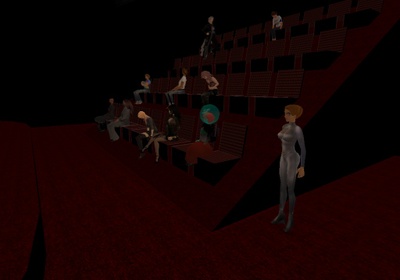Second Life Philcon
by Pixeleen Mistral on 20/11/06 at 11:54 am
by Budka Groshomme, Raving Reporter – Science Fiction desk

some virtual Philcon attendees check under their chairs for a griefer’s bomb
With the sweep of flashing fingers across multiple keyboards the Philadelphia Science Fiction and Fantasy Society Convention’s inaugural Second Life/Real Life panel was underway on Saturday at 0700 PST. This was the second East Coast meeting after the 2005 meet and greet in New York. In contrast to the earlier event, there was two-way streaming video allowing in-world residents to watch the panels at the Sheraton Philadelphia City Center in Pennsylvania while the fans at the convention could watch the audience in SL.
The somewhat tiny hotel meeting room was noisy and warm, partly from the output of multiple laptop computers, but mostly by the boisterous enthusiasm of those most eager to demonstrate aspects of their intriguing world.
Sitting in the SF museum’s auditorium were avatars of the RL members of the panels and audience as well as other interested SL residents. In RL there were SL fans, professional SF writers and the occasional bemused spectator probably wondering what this virtual world portended for their own future.
Most science fiction fans have become sophisticated about the concept of virtual worlds since the genre has dealt with the concepts, ethics, and other sociological and technical issues surrounding virtual worlds for over fifty years. In fact, Gwydion Nephilim, the avatar managing this convention track, stated that he was inspired by Neal Stephenson’s novel’s Snow Crash description of “the street.” Similar stories emerged from other panelists, such as Flipper and Jennifur Perrigrine, Crucial Armitage, and Nexus Fatale. At other times during the day others spoke to their own reasons for engaging in the social, economic, and artistic life of the virtual world and its impact on their real-life lives and professions.
For years science fiction has dealt with discerning the differences between the real and the virtual experience as well as the moral dilemmas posed by virtual property that does, and can, exist in an artificial computer network. All of these subjects were discussed in detail in several panel discussions.
There were some issues in getting the sessions started: Those who brought laptops were stymied by a slow and admittedly overloaded wi-fi network, while in-world the avatar overloading created lag, which crippled some displays, and there were the usual video time-delay issues and client crashes that make SL such an interesting experience. All in all, everything went as smoothly as could be expect for an inaugural run.
Momentary panic ensued at one point when a false rumor told everyone to check under their seats for a griefer bomb, an announcement which was met with more hilarity than panic.
The Saturday morning panel began with basic orientation for the uninitiated (but mostly just to show off our wonderful SL platform.) The majority attending were the already converted but there were a few not acquainted with SL.
The audience waxed and waned throughout the day from a bare handful of people to over 30 people. Similarly, the number of avatars changed constantly.
Other participants, such as Red Ridenour and Lawrence Schoen spoke to the uses being made of second life in the real world, such as therapeutic applications of guided psychotherapy, sites set up to aid Asperser’s syndrome families, and Support for Healing. Current and future applications of the SL platform were also discussed.
Throughout the day, a revolving and changing array of guest panelists, including several well-know writers, guided the discussions across the broad range of virtual world issues. The discussions and interrelationship of the issues were so interwoven that it was difficult to determine exactly what the panel subject was supposed to be.
As the day wore on the audience on both sides of the display screen tired as they addressed the monetary issues of income and value, the problems of governing those who owe no loyalties and whose actions have no RL consequences, games, and even the current and potential business and educational aspects.
Finally, late Saturday night (2000 PST), the exhausting sessions climaxed with a raucous and crowded sexuality panel, the highest attended session of the day, both in-world and out. Chaos was filled with 20-30 avatars while the session room was crowded with a similar number.
This session, which frequently devolved into a crude shout-out, covered the meaning of sexuality in artificial worlds. An all-too frank discussion (and demonstration with avatar, buffalo, and sheep) of cybering covered whether such activity aided or facilitated anti-social behaviors in the real world. This is particularly pointed in an atmosphere where no resident can be completely certain of the sex or motivations of another. The key conclusion from the hour and a half session was that without emotional content such activities were little more than eye candy.
Comments by the uninitiated exiting the many sessions varied from “What the hell?” or “I gotta find out how to sign up for this [expletive deleted] bad ass thing” to an enthusiastic admission that SL represented the greatest time sink anyone had developed.
As a recruiting effort this conference track was moderately successful, although more rewarding for those who were already residents than as a recruiting mission. The opportunity for each of the attending SL residents to reach beyond the familiar avatars and interact with the human manipulators made all the effort of putting this day-long event together worth every Linden spent.






Recent Comments